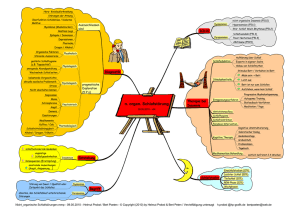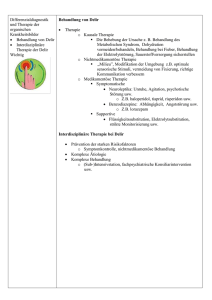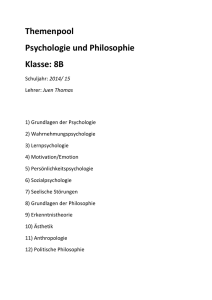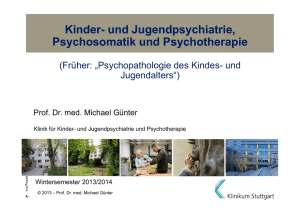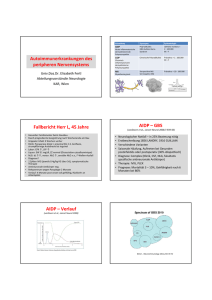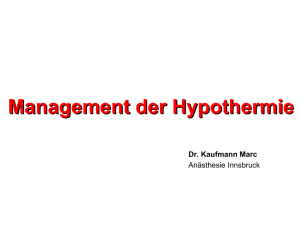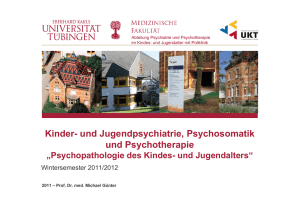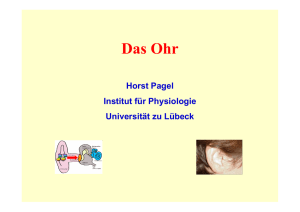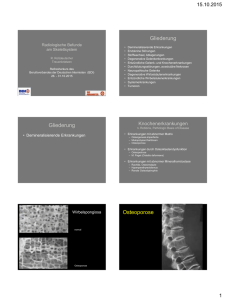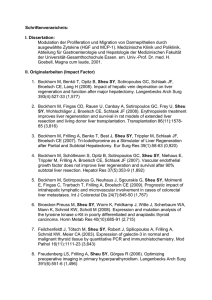L-T4 - DGBS
Werbung
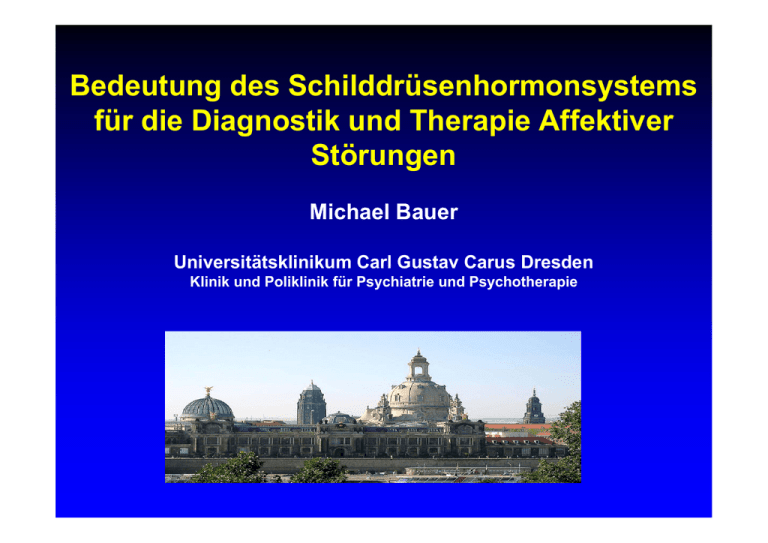
Bedeutung des Schilddrüsenhormonsystems für die Diagnostik und Therapie Affektiver Störungen Michael Bauer Universitätsklinikum Carl Gustav Carus Dresden Klinik und Poliklinik für Psychiatrie und Psychotherapie E. T. Kocher Dtsch. Z. Chir, 1874 Geschichte • Erkrankungen der Schilddrüse können zu schweren psychiatrischen Störungen führen 1888 Clinical Society of London - Report on Myxedema • 1891 Murray (England) - Erfolgreiche Behandlung des Myxödems mit getrockneten Schilddrüsenextrakten (Schaf) • 1936 Gjessing (Norwegen) - Erfolgreiche Behandlung der Periodischen Katatonie mit Schilddrüsenextrakten (Schaf) Regelkreis des Schilddrüsensystems: Neuroregulatorischer Negativer Feedback Loop Hypothalamus 1963 TRH Hypophyse negative Rückkopplung TSH Schilddrüse 1952 T3, Thyroxin (T4) Überschneidung depressiver und hypothyreoter Symptome Depression Hypothyreose Schwäche Ödeme Interessenverlust KälteDenkverlangsamung Grübeln intoleranz motor. Verlangsamung Schuldgefühle raue Stimme Mattigkeit, Schläfrigkeit Suizidalität trockene Haut gedrückte Stimmung GewichtsBradykardie Konzentrationsverlust verlangsamte störungen Reflexe Obstipation Lethargie Bauer M, Whybrow PC (2003) In: Wolkowitz OM, Rothschild TJ (eds.) Psychoneuroendocrinology: The Scientific Basis of Clinical Practice. American Psychiatric Press, San Diego, pp. 419-444 Assoziation des Schilddrüsensystems mit ZNS-Entwicklung • T4/T3 essentiell für ZNS-Entwicklung • Kretinismus, Oligophrenie • TSH Neugeborenen-Screening Bauer M, Whybrow PC (2003) In: Wolkowitz OM, Rothschild TJ (eds.) Psychoneuroendocrinology: The Scientific Basis of Clinical Practice. American Psychiatric Press, San Diego, pp. 419-444 The Brain-Thyroid Hormone Pathway: Novel Insights Abbreviations: D1, deiodinase 1; D2, deiodinase 2; D3, deiodinase 3; rT3, reverse T3; RXR, retinoid X receptor; T2, di-iodothyronine; THR, thyroid hormone receptor; TSHR, TSH receptor. Dayan CM and Panicker V (2009) Novel insights into thyroid hormones from the study of common genetic variation Nat Rev Endocrinol Wegen der Symptomüberschneidung und potentiellen Reversibilität psychiatrischer Symptomatik (Depression, Demenz) der Hypothyreose ist die Untersuchung des Schilddrüsensystems von heuristischem Wert fuer die Pathophysiologie psychiatrischer Erkrankungen Assoziation von Schilddrüsenhormonstatus und Zahl der Rückfälle bei bipolaren Störungen Frye et al. (1999) Am J Psychiatry Assoziation von Schilddrüsenhormonstatus und Ansprechen auf antidepressive Therapie bei bipolaren Störungen Cole et al. (2002) Am J Psychiatry Influence of Lithium on Peripheral Thyroid Physiology Thyroid growth by TSH Blockade by Lithium T3 T3, T4, bound to thyreoglobuli n Active Iodine uptake T4-synthesis Blockade by Lithium T4 Blockade by Lithium Demographics and Clinical Characteristics Patients N=96 Controls N=96 33/63 33/63 50,5 (12,7) 47,5 (11,7) 41 17 27 26 Duration thyroid hormone substitution (mo.) 81,3 (78,8) 120,6 (151,0) Duration lithium therapie (mo.) 128 (90,3) - Comedication with L-thyroxine 41 5 sex (m/w) age yr, (SD) Own history thyroid disorder family history thyroid disorder Bauer et al. J Aff Disord 2007;104:45-51 Ultrasonographic examination in lithium-treated patients Thyroid volume (ml, SD) all no L-thyroxine (n=55/91) with L-thyroxine (n=41/5) Prevalence of goitre (N) palpation ultrasonography all no L-thyroxine (N=55/91) with L-thyroxine (N=41/5) Patients N=96 Controls N=96 p 23,7 (16,5) 25,4 (13,4) 21,5(19,9) 13,6 (8,5) 13,0 (7,0) 25,1 (20,7) <0,001 <0,001 n.s. 24 12 <0,001 53 38 15 19 16 3 <0,01 n.s. n.s. Bauer et al. J Aff Disord 2007;104:45-51 Women are at higher risk to develop thyroid disease after lithium treatment Kaplan-Meyer analysis for development of thyroid disorders (hypo and hyperthyroidism) in a cohort of 115 males (| ) and 159 females (♦) prospectively followed for 53.1 months (range 14-87). The vertical axis clearly indicates the increasing number of women developing thyroid disease with age men women Kirov et al. 2005, J Aff Disorders Lithium Challenge Studie • Sind Patienten mit Rapid Cycling Bipolarer Störung sensitiver gegenüber einem Challenge-Test mit Lithium? • 20 unmedizierte Patienten mit RC-BD vs. 20 (gematcht für Alter und Geschlecht) • 4 Wochen Lithium-Therapie (> 0.5 mmol/L) • SD-Funktionstests, TRH Stimulationstest Gyulai, Bauer, Whybrow et al. (2003) Biol Psychiatry 53:899-905 Hypothese der latenten Hypothyreose Überschießende TSH Antwort im TRH Test bei bipolarer Störung (Demaskierung mit “lithium challenge”) 40 TSH (µU/mL) 35 Interaktion: Behandlung x Diagnose p=0.023 30 25 Prä-Lithium 20 Post-Lithium 15 10 5 0 Bipolar (N=20) Gyulai, Bauer et al. (2003) Biol Psychiatry Gesunde (N=20) Schilddrüsenhormone als Stimmungsmodulatoren • Accelerationsbehandlung (T3) (Wirkungsbeschleunigung AD, Akuttherapie) • Augmentation (T3, L-T4) (Wirkungsverstärkung AD, Akuttherapie) • Adjuvante Phasenprophylaxe (L-T4) (Wirkungsverstärkung Mood Stabilizer) Bauer M, Whybrow PC (2002) Thyroid Hormone, Brain and Behavior. In: Pfaff DW et al. (eds.) Hormones, Brain and Behavior. Academic Press, San Diego, pp. 239-264 Rezidivprophylaxe bipolarer Störungen: Senkung der Episodenzahl mit supraphysiologischer L-Thyroxin-Therapie (Mirror-Image Analyse, N=21; 16 F, 5 M; m=47 yrs) # Episoden 9 8 7 6 5 4 3 2 1 0 8,6 Mittlere Behandlungsdauer: 51 mth (m=378 mcg/d) 5,8 vor L-T4 ** ** 2,8 2,4 nach L-T4 2,4 ** 0,3 Gesamt Depression Manie * * p<0.01 (Wilcoxon test) Bauer et al. (2002) Neuropsychopharmacology Abnahme der Depressionsschwere unter supraphysiologischer L-Thyroxin-Therapie bei therapieresistenter Depression (N = 17) HAMD-SCORE 30 26.6 25 20 ** 11.6 15 HAMD-21 10 5 0 Prä T4 Bauer et al. (1998) Neuropsychopharmacology Post T4 Woche 8 **p=0.001 Remission Therapieresistenter Depressionen unter Supraphysiologscher L-Thyroxin Therapie 11% Partial-Remission N=2 Remission N=8 47% P os t T$ 41% Non-Remission N=7 Bauer et al. (1998) Neuropsychopharmacology 18:444-455 Verträglichkeit supraphysiologischer L-Thyroxin-Therapie: Major Depression vs. gesunde Kontrollen (Schilddrüsen-Symptom Liste) 28 * Summenscore 24 ** Pre-T4-Tx Post-T4-Tx 20 16 12 8 *P<0.05 vs. Kontrollen 4 **P<0.05 vs. Prä-L-T4 0 Depressive Patienten Bauer et al. (2002) J Affect Disord Gesunde Kontrollen Serumkonzentrationen Freies Thyroxin (fT4) bei Major Depression und Gesunden Kontrollen unter supraphysiologischer L-Thyroxinbehandlung (8 Wochen) Tx x Diagnosis P=0.006 fT4 (ng/L) 50 46 42 38 34 30 26 22 18 14 10 6 2 -2 45.4* 28.3* Vor T4 Nach T4 8.9 Patienten 9.7 Kontrollen Physiologische Parameter unter hochdosierter Langzeitbehandlung mit L-Thyroxin bei affektiven Störungen (N=21) 125 119 79 77 79 85 73 72 Prä L-T4 Studienende RR syst RR diast Puls Bauer et al. (2002) Neuropsychopharmacology Gewicht alle Unterschiede nicht signifikant Coregistration of PET Images to Structural T1 MRI using Automated Image Registration (AIR) Software* PET MRI * Woods et al., J Comput Assist Tomogr 1993;17:536 PET-Studie: Abnahme depressiver Symptomatik unter hochdosierter L-Thyroxin-Therapie bei Frauen mit bipolarer Depression 45 HAMD-21 / BDI 40 Beck Depression Score 35 Schwer depressiv 30 25 Mittel-schwer 20 15 * HAMD-21 Leicht-mittel schwer 10 * 5 0 0 1 2 3 4 5 6 7 Wochen L-T4 Therapie Bauer et al. (2005) Mol Psychiatry *p<0.001 PET Acquisition & Bild Analyse • [18F] Fluorodeoxyglucose PET • Aufmerksamkeitstest (Auditory Cont. Performance Task, CPT) • “Volumes of Interest (VOI)” Analyse • “Statistical Parametric Mapping (SPM 99)” Identifizierung regionaler Aktivierungen und Deaktivierungen im gesamten Gehirn Vergleich der PET Bilder zwischen Prä- und Post T4 Therapie (“voxel-by-voxel method”) Bauer et al. (2005) Mol Psychiatry Studienteilnehmer • 10 Frauen mit Bipolarer Depression • Bipolar Type I n=9, Type II n=1 • Euthyreoter SD Status baseline (TSH and fT4) • Alter: 39.3 + 7.8 • Jahre krank: 20.4 + 7.0 • 10 Gesunde Kontrollen, 35.9 + 9.3 Methoden L-T4 Dosierungsschema • Woche 1: 100 mcg/d • Woche 2: 200 mcg/d • Woche 3: 300 mcg/d • Woche 4: 400 mcg/d, bei non-suppression von TSH FDG-PET bei bipolarer Depression: höhere Aktivität in subcorticalen limbischen Regionen – niedrigere Aktivität im mittleren frontal Gyrus Middle Frontal Gyri Thalamus Ventral Striatum Amygdala y = -2 mm y = -44 mm X = -18 mm t-values 7 4 6 5 4 3 2 3 2 1 1 Cerebellar Vermis z = -42 mm Bauer et al. (2005) Mol Psychiatry Hippocampus 0 Bipolar > Control Control > Bipolar z = -8 mm FDG-PET bei bipolarer Depression: Deaktivierung limbischer und subkortikaler Hirnregionen unter L-Thyroxin-Therapie Thalamus Amygdala Dorsal Striatum x = -16 mm z = -16 mm t-values Hippocampus z = -2 mm Bipolar Subjects 5 Ventral Striatum 4 3 2 1 Cerebellar Vermis 0 z = -40 mm Bauer et al. (2005) Mol Psychiatry Scan 1 > Scan 2 z = -12 mm Multicenter, Randomized, Double-Blind, Placebo-Controlled Study of Levothyroxine (L-T4 - 300 mcg) as Add-on Treatment in Bipolar Depression – Study Design 1st FDG-PET 2nd FDG-PET The Stanley Medical Research Institute, trial grant # 02T-238 (P.I. M. Bauer) Change in depression scores (HAMD) during 6-wk of treatment with levothyroxine ITT – Population, LOCF analysis Stamm et al. (2013) J Clinical Psychiatry in press Primary outcome: Change in HRDS-17; ANOVA P = 0.12 L-thyroxine does not separate from placebo in men, but in women Stamm et al. (2013) J Clinical Psychiatry, in press Tolerability and side effects Signifikant more frequent with L-T4: inner restlessness; trends towards weight loss T3, T4 Affektive Störungen Schilddrüsenhormonsystem
